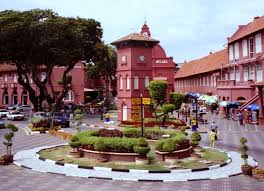
Brief outline of the low carbon town development plan
Melaka is the smallest of 14 states in Malaysia and home to Melaka city, a rich center of heritage that was recently listed as a UNESCO World Heritage Site. Melaka was a prominent trading center in the 16th century that attracted traders from all over eastern and western Asia including India and China. Strategically located on the Malaysian Peninsula and along the narrowest portion of the Malacca Strait, Melaka attracted a lot of interest from European settlers, who sought to control movement of ships between the Indian Ocean and the South China Sea.
Urban Characteristics
Melaka state consists of four municipal districts – Alor Gajah, Jasin, Melaka Tengah, and Hang tuah Jaya. Melaka Tengah is the most built out, with the highest urban density, and includes the historic Melaka center. Alor Gajah and Jasin are still predominantly agricultural districts, while Hang Tuah Jaya is a newly created planned district that has become the new state government center.
IN the last five years, Melaka has made great strides toward building a sustainable, green city.
By 2020, the government-run 7,248ha Melaka World Solar Valley aims to power most of the daily activities of manufacturers, housing developers, farmers, and other stakeholders.
Recently, a public-private partnership installed 100,000 LED street lamps along the Alor Gajah–Central Melaka–Jasin (AMJ) highway, which will improve road safety and reduce carbon dioxide emissions.
The urban landscape has also changed. While glinting glass panels adorn this Malaysian state, a former trading hub with rich multicultural heritage, walkable neighbourhoods with mixed-use development have increased foot traffic and reduced car use in the fast-growing state.
The Melaka River, once a polluted drainage canal, is now a popular gathering place and tourist attraction.
Melaka’s transformation is the result of meticulous planning, a comprehensive approach supported by government policies and projects, private sector engagement and citizen initiatives.
The Asian Development Bank (ADB) have worked with Melaka to develop its roadmap, the Green City Action Plan. In addition to a technical assistance grant to underwrite the plan, which was completed in 2014, ADB also helped Melaka implement it, including by structuring bankable projects for solar energy and street lighting, setting up a database to track indicators in environment and economic growth, and conducting training in urban development, environment planning, and knowledge sharing.
Melaka Green City Action Plan
-Melaka is well recognized as a world heritage city that receives millions of visitors annually.
-Melaka is a growing community and expects to add more than 120,000 residents between 2011 and 2020.
-Manufacturing is strong, and was responsible for approximately 45 percent of Melaka’s GDP, and nearly 29 percent of the jobs in 2011.
-Nearly two-third of Melaka is categorized as Environmentally Sensitive Areas due to ecological reasons such as rich biodiversity.
-Agriculture is still prominent as a land use and occupies half of the land in Melaka.
-Portions of Melaka, particularly the historic part, reflect green design characteristics such as walkable neighborhoods, and mixed use developments that reduce the need for auto use.
-By transforming the Melaka River from a drainage channel to a popular and award-winning cultural amenity, Melaka has already demonstrated its leadership in successfully implementing an integrated project.
-By implementing one solar farm project with a second one already in preparation, Melaka is on its way towards large scale production of renewable energy
-Malaysia and Melaka have a policy framework supporting sustainable urban development.